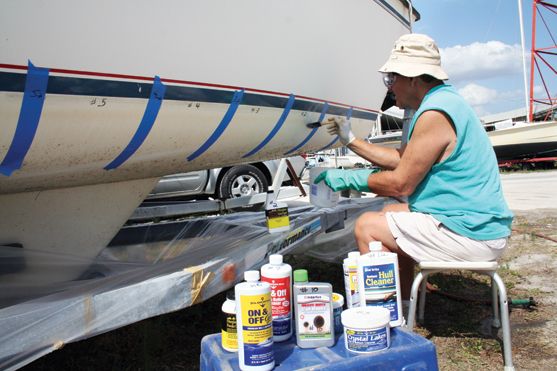Summer is here, and our routine maintenance chores now require some serious elbow grease. Our first impulse is to go for the super-strength acids that will take care of the hard growth as well as the stains. But there are kinder, gentler options, if you have the willpower and the patience.
Over the years, Practical Sailor has reviewed several eco-friendly products that do a good job of descaling heat exchangers and removing barnacles. Barnacle Buster from Trac Ecological (Practical Sailor May 2007) and Rydlyme Marine from Apex Engineering (Practical Sailor March 2008) both dissolve calcium carbonate, the main ingredient in lime scale and shell. Both products are biodegradable and can be released safely into the environment. Barnacle Buster contains phosphoric acid, while Rydlyme uses a less caustic proprietary recipe with the active ingredient hydrochloric acid.
Other products like Star brite Zebra Mussel and Barnacle Remover or MaryKate On & Off deal with shell and scale well, but they contain stronger concentrations of hydrochloric acid that give off toxic fumes and are beastly to work with. No matter what the instructions say about disposing of these chemicals responsibly, few people bother to corral these liquids, get them back into containers, and take them to the local HazMat station. They end up in the ground, the air, the water, or us-often all four.
Green Cleaners

The trouble with brown-yellow waterline stains is that they’re often made up of more than one problem-a combination, for instance, of algae stain, pollen, and tannic-acid stains, plus oil stain, all in a matrix of salt and strange oxides. Attack them with a gritty cleaner like Ajax, and you’re liable to damage the gelcoat.
In the November 2007 issue, Practical Sailor tested 22 waterline stain removers. All but one contained oxalic, hydrochloric, sulfuric, or other acids, or some mixture of them, and all were rated Good or Excellent. This is not chemical rocket science. The overall Best Choice and Budget Buy was Spray Nines Boat Bottom Cleaner, a gel containing multiple acids. It was still more pleasant to work with than most of the other products.
Most waterline stain removers use harsh acids to banish the brown funk. If the stain isn’t too bad, try cleaning it with concentrated lemon juice first. The most eco-friendly product tested was Captain Johns Boat Brite Algae and Waterline Stain Remover, which earned a Good with just a little rubbing. All of these cleaners removed wax in our testing, so following with a quick cleaner-wax will help keep the stains from coming back quickly.
One way to reduce the work load is to stay ahead of stains by more regular sponging of the boot-top and waterline. A thorough buff-and-wax job using one of our top-rated hull waxes goes a long way toward keeping the waterline clean. If things start to get ugly, I’ll use milder green formulas that fared well in our tests, or any you might recommend. (Reader Bob Kramer of Callao, Va., advocates using concentrated lemon juice for stains not yet deeply set in.) And if things get really bad-or if I put everything off until next April-the occasional acid-based cleaner will do the trick.
The waterline stain remover test is one of several in our e-book Gelcoat Restoration and Maintenance, part of a three-part series on marine cleaners.




































